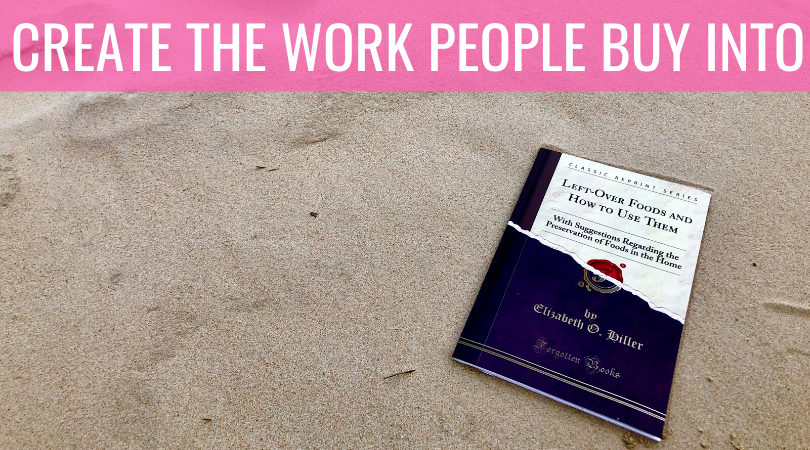How To Create Work That People Will Buy Into

The people you create your blog, podcast or video for don’t want to hear lots of jargon or business-speak that proves your expertise.
They’re not looking for long-winded persuasion backed up by reams of data.
They don’t want to hear another so-called industry thought leader insisting their way, is the right way.
They want to know what’s in it for them.
They want to see themselves joining, working with or buying from you. And when your message resonates with them in this way, it becomes much easier for them to make a commitment to you.
It works like this: Taking your values, your point of view and the product or service you offer, you create and develop a body of work that shares a message that makes a deeper connection with your audience, something that plays into an emotion.
A few years ago, my business message centred around telling people why a content marketing or inbound approach could be of benefit to them.
Now, I rarely talk about content marketing as such. My messages focus on how businesses can find and build customer loyalty through owning their means of communication. The principles of what I’m saying are still with content marketing, but framed in a way that is more resonant and easily understood.
Finding A Way To Connect With Others
Extracting a simple and individual way of conveying your message is tough. You persist with it so that the people you want to reach are able to take your message on in the easiest way possible. In this way you both win.
Janet Murray was our guest speaker at the first You Are The Media Lunch Club of 2020 in Bournemouth (she also kicked off the year of YATM workshops). The topic was the importance of building an audience.
We shared the significance of being in the business of creating – just starting something, honing a message, developing a rhythm and acquiring familiarity.
Everything we talked about derived from the principles of content marketing, but neither of us used this term in our conversation (although I did refer everyone to this point).

This approach resonated with our audience because the language we used wasn’t mired in marketing industry terminology. In being plain and everyday, it was appropriate for the setting, event and worked for everyone who was there.
What you do to achieve this is switch from telling people about what you sell in terms of your solutions, to focusing on the value you provide in real world terms. Recognising the one word you stand for can help with this, click here to read this article.
END Result, In SMALL Steps
Demonstrating the value you bring works best when you share the end result, explaining it through the small steps that need to be taken in order to get there.
In doing this you’re sharing a picture of what a better tomorrow could look like for them.
Let me share with you how one brand at the start of the 20th Century invented the word ‘leftovers’ (full credit to Dave Trott for this example).
The word leftovers didn’t exist before 1910. Before the advent of fridges it was difficult to store fresh food – you bought what you’d consume on a daily basis. Domestic fridges, introduced in the early part of the 20th Century took a while to become popular. One fridge manufacturer, the McCray Refrigerator Co, decided that they’d sell more fridges if they created a need for them – so they invented the concept of leftovers and with it, the initiative to educate people about how a fridge could help them.
In doing this, McCray sold its customers a vision of their future – the end result of buying a McCray fridge – they could make their food go further, keep it fresh and reduce waste.
In 1910 McCray commissioned Elizabeth O. Hiller to write a book called Left Over Foods And How To Use Them: With Suggestions Regarding The Preservation Of Foods At Home. You can still buy the book on Amazon. Elizabeth O. Hiller was well-known at that time – a professor and established cookbook author. Her credibility further enhanced the place McCray were coming from with their leftovers initiative.

The book was another of the small steps, it provided a means of further expanding on the benefits of fridge ownership. When you share what the future looks like in a way people can identify with, it becomes easier for them to put themselves in the picture with whatever you’re offering them.
What About You?
Creating work that people understand and relate to, comes down to the values you have, beyond the immediate return.
Let me highlight some examples of end results:
— Your children going to an after school club = their safety, your peace of mind
— Working with a law firm = confidence
— Being part of a networking group = inclusion
— Going to the gym = well-being
When you work backwards from the end result, breaking down the “how you get there” into smaller steps it builds context and also gives you a far wider scope to explore and document.
This is the work you share via your blog, podcast and video. For instance, a podcast series that has a focus on that bigger goal of all of us needing to feel we belong, i.e. inclusion, has far more resonance than a message that looks narrowly at the beneficial function of of business-to-business networking.
Connecting your audience to the emotional part of the end result you can provide is what makes you and what you’re creating, relatable, bringing you closer to your audience.
They are then more likely to commit to sign up and buy from you.
I love this sentiment from Bernadette Jiwa who shared recently, ‘It’s not enough to tell people what they get as part of the transaction today. We need to show them how those features will become benefits that matter to them in the long run.’
Here is what’s in it for you when others buy into a future that has what you offer in it:
You create moments and experiences.
By finding a way to gather the right people around you, you then figure out a way to ramp up the interaction. For instance, if the YATM Lunch Club was purely regarded as a networking event, it would not have stood the test of time since 2016.
You strengthen your connections with the people who get “it” and you.
Turning people away and knowing who shouldn’t come on board is just as important as attracting the right people. When you know what you are not, you have a filter and it becomes easier to create and share the right sort of material.
You create something that others want to pass on within their networks and share.
When your message resonates with people it’s only natural that they want to share it. This is far more powerful and on a totally different level to someone simply sharing reasons why their business is great to work with.
When you speak someone else’s language, you have the potential of having a friend/customer for life.
This represents getting closer to others, being relatable and the importance of trust. As mentioned in the last article click here that was about trust, there is potential for individual businesses to step up and take responsibility for having a voice in their particular sector and community, for taking the lead and/or joining with others to build momentum and effect change.
Let’s Round-Up
The message you create and the values you have are at the heart of the space you own.
You build your business from what you care about and stand for, and how that connects with the people you’re looking to reach. Your shared focus – yours and your customers’ and clients’ – is what you should concentrate on.
Making that emotional connection with them, showing them the end result of how their relationship with you can play out. Finally, back it up with the small steps it will take to get there. This demonstrates your value and makes their choice all the easier.
Podcast: Play in new window | Download


